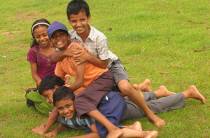
Learning Difficulties: possilbe causes and solutions
© Mira Katja Watson, Sep 2011
ADHD, ADD, autism, dyslexia, dyspraxia, dysfunction and many more depressing labels put the child in a box of behavioural symptoms but don’t necessaily help them feel better. Sometimes the labels prevent the children from being treated normally, and so they respond to these negative expectations even more. These learning difficulties have titles that are so hard to get the meaing of that I’m having trouble reading them as an adult. If you are a parent with a child who has been given one of these labels, ask yourself if the label is helpful, and if you have been given practical pointers for resolving the condition, or just a bottle of pills and condolences. If so, you may consider handing the label back and finding a workable solution from amongst the range of alternative treatments on offer.
Learning difficulties can on the whole be treated, often fairly quickly and simply if you are prepared to open your mind to looking at things from a different perspective. The perspective given here is that they are a symptom of a fundamental disconnect within the child, which makes it hard for them to engage with their surroundings. This may have a viariety of causes, which must be identified and tackled so that the child can find a healthy and stable connection with themselves, and a sense of safety in interacting with people and their environment…
Identifying the issue properly is important…
 |
It is also important to distinguish between a child that does not seem to learn, (for example Thomas with his nervous ticks) and a child that is restless and hyperactive because they are intelligent and capable but not being understood or stimulated in their school environment. If they are being labelled as ADD because they don’t fit in and are too demanding for their teacher, then the issue is to provide the right kind of attention and stimulation, to engage the child properly, and not to try to calm them down… |
I have just had a mother on the phone telling me her daughter has a disorder called “visual distress” syndrome. They’ve given her glasses with rose coloured filters and told her she is dyslexic too. And that’s supposed to solve the situation. I thought it was a joke, but she was serious. If you are interested in how her treatment progressed, please read the featured families article on divorce trauma. Let’s see if we can inject some common sense and practical action into the discussion to help you find some of your own answers.
So let’s begin with a reflection on the visual conditions – any apparent inability of a child to read, see or relate to the surroundings effectively. Of course from a narrow perspective, which is what you tend to have if you can’t see, the problem would seem to originate in the eyes or the brain. However if we expand our vision somewhat, there are often other factors, such as high stress levels in the child, emotional tension, history of divorce or loss which create visible tensions in the child’s shoulders, neck, back, belly and even legs.
Grounding
When a child’s body or emotions hold a considerable amount of tension, their experience is often of being beside themselves, or of watching themselves, or of floating a little above the ground, and of not being able to focus and concentrate. Whether this tension is physical or emotional is not that important – it needs to be resolved. Otherwise the child can’t see properly – the experience may be rather like how the adult vision gets blurry after drinking too much alcohol. A drunk adult can’t see straight, read road signs or get the details of their surroundings. It’s seems to be similar for a visually challenged child, only they feel like this most of the time.
Craniosacral therapy is a useful alternative treatment for sight-related learning difficulties, as working with the tension held between the cranial base and the sacrum can be enough to relax the whole of the child’s system and enable them to reconnect with their body. Once a basic grounding is established, more specific holding in the skull and eye muscles can be adressed directly, if necessary. The point is the child is able to sense their body again from the inside, which is so often lacking in children with learning difficulties.
If you have a child that always walks on tiptoes, and appears to be only half there most of the time, you can practise the following with them daily to help them get a sense of their body:
Ask your child to take off their socks and shoes, and blindfold them. Gently lead them over a variety of surfaces, eg. Carpet, tiles, pebbles and grass, and ask them to identify through the feeling in their feet what they are walking on. You can ask them details like temperature, rough, smooth, texture, guess the colour etc. to help them. You may also like to tell them that they can pretend to have eyes in the soles of their feet to “see” the ground with. Later you can repeat this exercise whenever the child seems especially disconnected, to help them sense their body. You may also like to tickle their feet with a variety of objects, and ask them what they are. The same exercise can be done blindfold with the hands guessing what objects are. The principle is the same. Over time your child will train themselves to use the body to sense, and getting comfortable with this experience will help them ground inside the body, which in turn helps brain development and schoolwork…
Releasing emotional trauma
Often the “dyslexia” resolves simply through the release of emotional trauma and reconnection into the physical body. The eyes energetically link into the core membrane system in the body running right down the spine to the sacrum and coxyx, and as such reflect the state of our core or central energy. When it is not grounded or flowing freely, the eyes are affected. Issues with the eyes often relate to preverbal trauma and issues of not bonding adequately with the mother. So they may require delicate handling. However, the earlier the better. With more ingrained patterns or experinces more work may be required to help the child to feel safe to express anger or life force authentically, until full vision is restored. Eyesight also relates directly to emotionally sensitive events that may be hard for us to experience or look at, and so physical vision is affected accordingly. Craniosacral therapy is therefore a useful alternative treatment for addressing these learning difficulties related to sight, reading and writing.
Food & Diet
ADHD and ADD often also have a component of extreme sympathetic nervous system overstimulation which is what gives the hyperactive component. This is the technical way of saying that the child appears constantly wound up. Craniosacral therapy is excellent for restoring balance to the nervous system as it works directly with the nervous system and brain to stimulate the parasympathetic system and calm things down. Often one or the other parent is fairly tense or hyper, and this is actually the cause of the child’s tense and overloaded nervous system. Obviously in such cases it is the parent’s therapy that will most benefit the child, who can then finally calm down and relax.
In addition, many of these children seem to benefit from some simple changes in diet, the principle one being to eliminate sugar. Sugar causes an energy rush and then a low, which in sensitive kids can cause really eratic and aggressive behaviour. Food additives and colours are also common culprits, and if your child seems hyper, it is a sensible precaution to stop fizzy drinks and processed foods, and even maybe look into a wheat and dairy free diet until symptoms die down, in addition to craniosacral treatment. Many children nowadays are highly sensitized to wheat, dairy, lactose, meat and chemicals in food and water, so fresh and organic diets are simply the only workable option. This is a strong message to the rest of us to take note too… For some children a change in diet alone brings about remarkable behavioural change. It can certainly kick start the healing process.
NAET Allergy Elimination Technique
| NAET allergy elimination treatment is simple and effective, and can be used as a diagnostic tool for food and additive intolerances. NAET can then be used to treat the sensitivities and open up the energy meridians associated with the allergy. This treatment works very well in combination with craniosacral. However some extremely traumatised children require sensitive cranio treatment before their body can respond to the muscle testing used for NAET. If the NAET practitioner says they can’t treat your child, then maybe try craniosacral therapy first. |  |
Vaccines
If you’d like to read more on the effects that vaccinations may have on the brain and their role in contributing to learning difficulties please take a look at this article. The good news is that the effects of heavy metal poisoning and membrane contraction can be largely relieved using a combination of NAET and craniosacral therapy. However it is important to redress the balance as soon as possible as the consequences can be lifelong and extremely debilitating. The sooner they are tackled, the sooner your child can continue to develop normally.
Birth Trauma
Some of these learning conditions may originate in trauma experienced at birth, by the cranium being squashed in the birth canal and the brain deprived of oxygen. The shock effects of birth alone are enough to affect the emotional security of some children, which can lead to all the above learning difficulties later on, if not diagnosed and treated. Craniosacral is a wonderful therapy for releasing birth trauma, which is best applied soon after birth, but still useful right throughout childhood for the same purpose.
To Conclude:
If a child cannot learn it is usually because of some fundamental inability to engage with their environment. Therefore the core way in which they are not feeling safe in themsevles, or are disconnected from themselves must be resolved. One aspect of this may be a lack of emotional engagement with the child, either in the family or school environment. If you feel this may be the case, then please read the article on emotional empathy.
This disengagement and the resulting learning difficulties in children cover a wide range of symptoms which if viewed from a wider emotional and physiological perspective can be treated according to emotional, physical and dietary components. We suggest that looking at elements of diet, allergy elimination, emotional history, birth trauma, phsycial stress and grounding can been an excellent starting point. We have found these treatments to be especially effective when combined with craniosacral therapy, since a healthy child is one whose core energy can flow unobstructed, and who feels safe and free to be themselves. When a child feels safe and supported s/he feels good in the physical body, and able to interact effectively with the environment. Then most learning difficulties are no longer an issue. Except the things which the child is not intersted in learning, and if so, please read the article on school issues. Always remember, if nothing works, treat the parents. They are most likely the cause.
